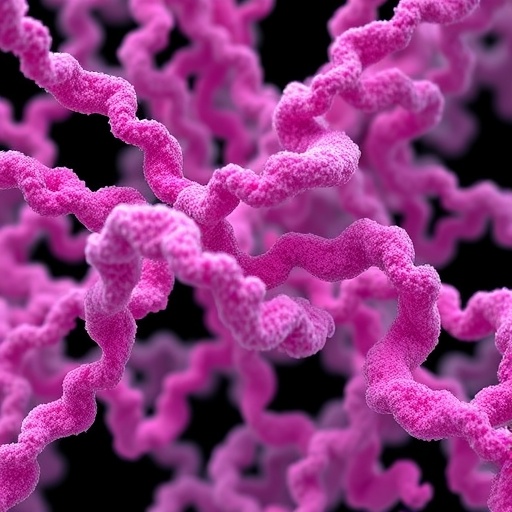A groundbreaking advance in the quest to combat Parkinson’s disease has emerged from the laboratory of Sevenich, Gering, Kass, and colleagues, who have demonstrated a revolutionary approach to dismantling the pathological aggregates that lie at the heart of this debilitating neurodegenerative disorder. At the core of their study, published in the reputable journal npj Parkinson’s Disease, is an innovative peptide-based strategy that directly disassembles alpha-synuclein preformed fibrils into their monomeric forms. This discovery holds immense promise for therapeutic intervention, potentially altering the landscape of Parkinson’s treatment by targeting the disease’s underlying molecular pathology with unprecedented precision.
Parkinson’s disease, a condition marked by progressive motor dysfunction resulting from the loss of dopaminergic neurons in the substantia nigra, has long been linked to the accumulation of misfolded alpha-synuclein proteins. These proteins aggregate into fibrillar structures known as Lewy bodies, which disrupt neuronal function and ultimately lead to cell death. Traditional therapeutic approaches have largely focused on symptom management or slowing disease progression through indirect means. However, the study from Sevenich and colleagues takes a radical step forward by directly targeting the fibrillar aggregates themselves, aiming to reverse the fundamental pathogenic process.
The team’s novel solution hinges on the use of an all-D-peptide—a synthetic peptide wholly composed of D-amino acids, which confer remarkable stability and resistance against proteolytic degradation. This structural uniqueness not only enhances the peptide’s bioavailability and longevity within biological systems but also equips it with the capacity to bind to alpha-synuclein fibrils and induce their direct disassembly. The researchers meticulously validated the peptide’s efficacy, meticulously documenting its ability to break down the fibrillar alpha-synuclein into monomeric units, which are far less toxic and pathogenic.
What is striking about this approach is its mechanistic clarity. Prior strategies often struggled with indirect targeting or required complex cellular machinery to reverse aggregation, but this all-D-peptide acts as a molecular disruptor, engaging directly with the beta-sheet rich fibrillar structure to unravel it. The peptide’s binding initiates a cascade of destabilization events, effectively ‘unzipping’ the fibril and liberating soluble monomers. This mechanistic insight advances the field by offering a tangible means to directly interfere with protein aggregation, a pathological hallmark shared not only by Parkinson’s but also other synucleinopathies.
Sevenich et al. leveraged a battery of advanced biophysical and biochemical techniques to characterize the interaction between the all-D-peptide and alpha-synuclein fibrils. Methods such as transmission electron microscopy (TEM), circular dichroism (CD) spectroscopy, and Thioflavin T assays provided robust evidence for the peptide-mediated fibril disassembly. These complementary data illustrated a gradual dissolution of mature fibrils, accompanied by a reduction in beta-sheet content—a signature conformational element of pathological aggregates. Importantly, the collection of evidence aligns to affirm the targeted and efficient nature of fibril disruption.
Beyond the biochemical milieu, the study explored the peptide’s functional implications in cellular models of Parkinson’s. Here, the peptide not only prevented further aggregation but actively reversed existing fibrillar deposits within neuronal cultures. These results underscore the therapeutic potential of the all-D-peptide by demonstrating a capacity not merely for prophylaxis but for remediation of already established pathological protein aggregates. The implications for disease-modifying treatment are profound, signaling a shift from symptomatic management to targeted molecular repair.
One of the remarkable features of the all-D-peptide strategy is its translational potential. All-D-peptides are inherently less immunogenic and more pharmacokinetically stable than their L-peptide counterparts, aspects that bode well for future in vivo applications. The researchers discuss the peptide’s ability to permeate cellular membranes, a critical prerequisite for effectively targeting intracellular aggregates. This cellular uptake, combined with the resistance to protease degradation, charts a promising pathway toward clinical development, potentially allowing systemic administration or blood-brain barrier penetration.
The therapeutic window afforded by direct fibril disassembly could also circumvent challenges that have impeded other therapies, such as antibody-based immunotherapies that rely on immune activation. By leveraging a purely biochemical mechanism, the all-D-peptide circumvents potential inflammatory side effects while directly addressing the misfolded protein burden. Such precision medicine elevates the possibility of reducing off-target effects and enhancing patient safety profiles, two pivotal concerns in neurodegenerative disease therapeutics.
Moreover, the study situates this breakthrough within the broader context of protein aggregation diseases. The method’s conceptual framework may be adaptable to other pathological amyloids beyond alpha-synuclein. Diseases such as Alzheimer’s, characterized by amyloid-beta and tau aggregation, could potentially benefit from similar peptide-mediated disassembly approaches, offering a versatile platform technology for neurodegenerative disorders grounded in aggregation pathology.
In the intricate battle against Parkinson’s disease, one of the largest hurdles has been addressing the stubborn, insoluble aggregates resistant to conventional treatments. Sevenich and colleagues’ demonstration of direct fibril disassembly represents a transformative leap. The clarity of their mechanistic insights, coupled with convincing experimental validation, establishes a robust foundation for further preclinical studies. The next frontier will entail validating these findings in animal models and investigating toxicity, pharmacodynamics, and ultimately clinical efficacy.
The scientific community has greeted this development with enthusiasm, recognizing the potential for a new class of therapeutics that could fundamentally change disease progression trajectories. While additional hurdles remain before translation to patients, the study provides a much-needed light at the end of the tunnel, one based on molecular precision rather than symptomatic relief alone. The discovery fuels optimism that Parkinson’s disease, historically considered intractable, may be confronted with effective disease-modifying therapies on the horizon.
Furthermore, the ability of the all-D-peptide to disassemble preformed fibrils implies potential use not only for early intervention but also for patients with established pathology. This feature is critical because Parkinson’s diagnosis often lags behind early pathogenic events. Having a treatment that can reverse existing pathological aggregates opens therapeutic windows previously deemed too late to intervene, offering hope to millions affected worldwide.
In addition to efficacy, the peptide’s design introduces a versatile scaffold for further chemical optimization. Structure-activity relationship experiments could yield derivatives with enhanced binding affinity or cellular uptake, allowing tailored therapies for different stages or subtypes of synucleinopathies. This modularity enables a personalized medicine approach, fostering therapies aligned with patient-specific molecular profiles—an exciting frontier in neurodegenerative disease management.
From a broader perspective, this work underscores the profound utility of D-peptides in biomedical science. Their exceptional stability, low immunogenicity, and unique interactions with protein aggregates position them as potent tools for drug design. This paradigm may extend beyond neurodegeneration, impacting fields such as oncology, infectious disease, and immunology, wherever pathological protein-protein interactions play critical roles.
In conclusion, the study by Sevenich et al. constitutes a landmark achievement in neurodegenerative research. By harnessing an all-D-peptide to directly disassemble alpha-synuclein fibrils into benign monomers, they have unlocked a new therapeutic avenue with far-reaching implications. This research not only advances our understanding of Parkinson’s disease pathology but also pioneers a generalizable strategy against protein misfolding disorders, propelling the field toward more effective and lasting treatments.
Subject of Research: Parkinson’s disease; disassembly of alpha-synuclein fibrils using all-D-peptides.
Article Title: Direct disassembly of α-syn preformed fibrils into α-syn monomers by an all-D-peptide.
Article References:
Sevenich, M., Gering, I., Kass, B. et al. Direct disassembly of α-syn preformed fibrils into α-syn monomers by an all-D-peptide. npj Parkinsons Dis. 11, 271 (2025). https://doi.org/10.1038/s41531-025-01132-7
Image Credits: AI Generated
Tags: alpha-synuclein fibrils disassemblydirect targeting of protein aggregatesdopaminergic neuron lossinnovative therapeutic strategiesLewy body pathologymolecular pathology of Parkinson’sneurodegenerative disorder researchParkinson’s disease treatmentpeptide-based therapyrevolutionary approaches to Parkinson’sSevenich research teamsynthetic peptide interventions





